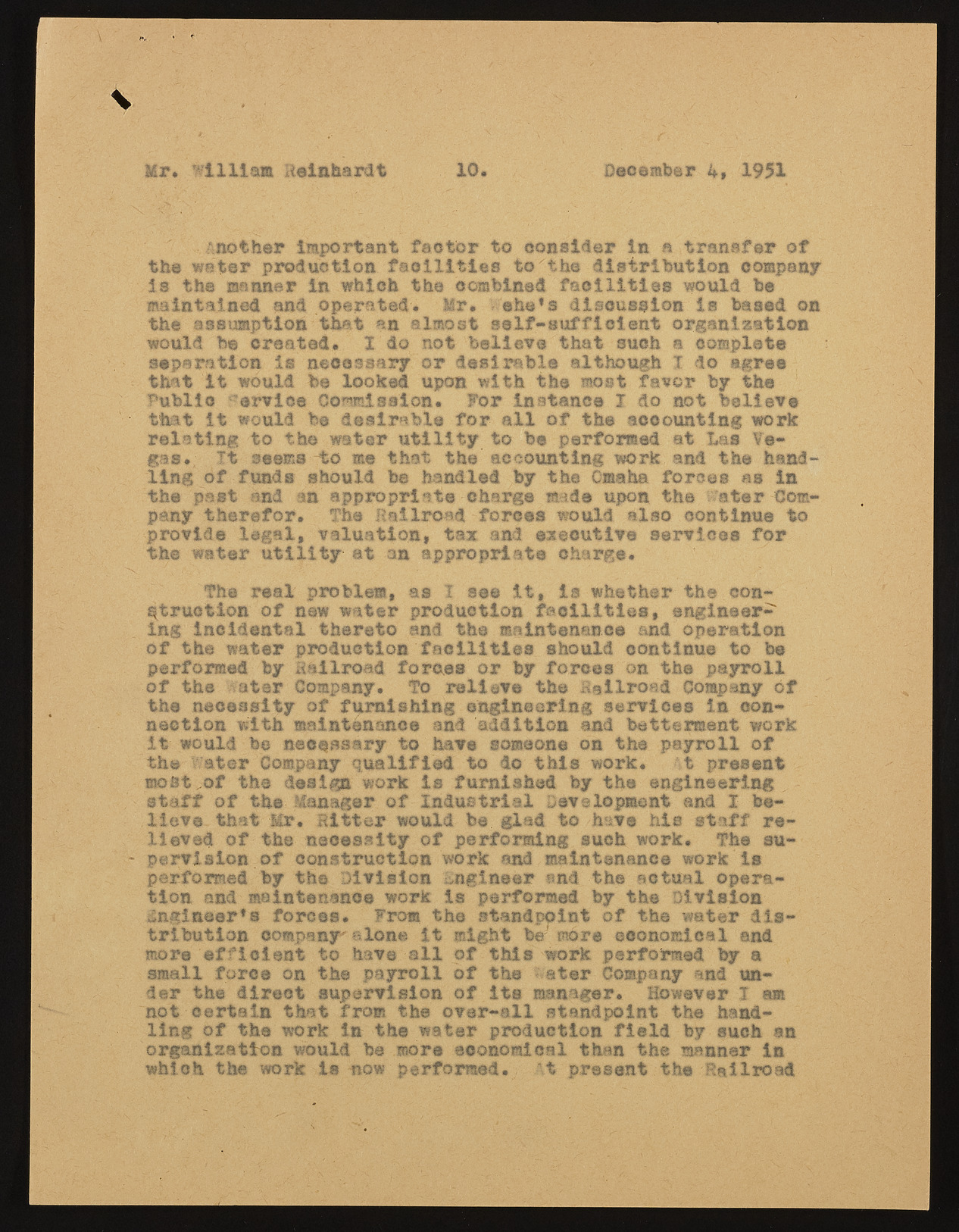Copyright & Fair-use Agreement
UNLV Special Collections provides copies of materials to facilitate private study, scholarship, or research. Material not in the public domain may be used according to fair use of copyrighted materials as defined by copyright law. Please cite us.
Please note that UNLV may not own the copyright to these materials and cannot provide permission to publish or distribute materials when UNLV is not the copyright holder. The user is solely responsible for determining the copyright status of materials and obtaining permission to use material from the copyright holder and for determining whether any permissions relating to any other rights are necessary for the intended use, and for obtaining all required permissions beyond that allowed by fair use.
Read more about our reproduction and use policy.
I agree.Information
Digital ID
Permalink
Details
More Info
Rights
Digital Provenance
Publisher
Transcription
Mr* William Reinhardt 10 Deoamber k, 1951 Another important factor to consider the water production facilities to the dis tirn iba uttiroann scfoemrp oafn y is the manner in which the combined facilities would be mtahei ntaasisnuemdp tiaondn otphearta taend .a lmMors*t seelhfe-’ss udfifsicciuesnsti oonr gias nibzaasteido non would be created* I do not believe that such a complete tsheapta raitt iwoonu lids nbee celsooskaerdy uopro nd ewsiitrhab lteh e amlotshto ugfha voI rd ob y agtrheee Ptuhbalti ci t Sweoruvlidc e beC omdmeissisriaobnl*e fForo r aliln sotfa ncteh e I adcoc onuontt ibnegl wioervke graesl.a tinItg tsoe emtsh e two amtee r thuatti litthey atoc cboeu ntpienrgf owromredk aatn d Latsh e ¥eh-a ndling of funds should be handled by the Omaha forces aa in pthaen y ptahsetr eafnodr *a n Tahpep rRoapirliraotaed chfaorrgcee s mwaoduel du poanls ot hec ontaitneure Cotomprovide legal, valuation, tax and executive services for the water utility at an appropriate charge. structTihoe n roefal neprwo wblaetme,r apsr odI ucsteieo ni t,f acisi lwithieetsh,e r etnhgei neceornoifng thIen cwiadtenetra lp rotdhuecrteitoo n anfda citlhei timeasi ntsehnoualndc e coanntd inoupee ratto iobne performed by Railroad forces or by forces on the payroll of the ater Company. To relieve the Railroad Company of ntehce tinoenc evscsiitthy m aoifn tfeunrannicseh inagnd eandgdiinteieorni nagn ds erbveitcteesr meinnt cwoonrk it would be necessary to have someone on the payroll of mtohset v.a.otf erth eC omdpeasingyn qwuoarlki fiiesd futor nidso hetdh isb yw otrhke. engit neperreisnegnt staff of the Manager of Industrial Development and I be lliieevveed tohfat tMhre. nReictetsesri twyo uolfd pfeere.f ogrlamdi ngto suhacvhe wohrike. stTahffe rseupervision of construction work and maintenance work is pteirofno ramnedd mabiyn ttehne anDciev iwsoirokn eisn gipneerfeorr meendd bthye tahcet uDailv iosipoenraEngineer’s forces. From the standpoint of the water d istribution company alone it might be more economical and msomrael l efffoirccei enotn tthoe hpaavey roallll ooff tthhei s -waotrekr Cpoermfpoarnmye da ndb y una ndoetr cteher tdaiirne ctth ats ufpreor®v isthieo n ovoef r-iatsl lm asntaagnedrp.o intH owtehev erh aIn dam olrignagn oifz attihoe nw oworukl di n bet hme owraet eerc onpormoidcuaclt itohna nf ietlhed mbayn nseurc h inan which the work is now performed. At present the Railroad

